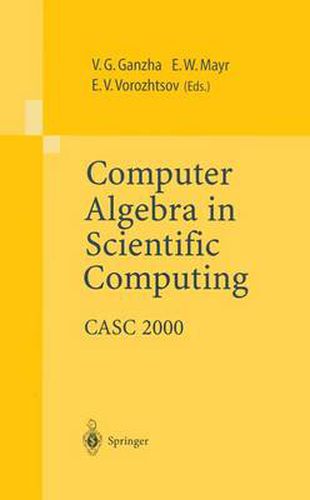Readings Newsletter
Become a Readings Member to make your shopping experience even easier.
Sign in or sign up for free!
You’re not far away from qualifying for FREE standard shipping within Australia
You’ve qualified for FREE standard shipping within Australia
The cart is loading…






This title is printed to order. This book may have been self-published. If so, we cannot guarantee the quality of the content. In the main most books will have gone through the editing process however some may not. We therefore suggest that you be aware of this before ordering this book. If in doubt check either the author or publisher’s details as we are unable to accept any returns unless they are faulty. Please contact us if you have any questions.
The vast area of Scientific Computing, which is concerned with the computer- aided simulation of various processes in engineering, natural, economical, or social sciences, now enjoys rapid progress owing to the development of new efficient symbolic, numeric, and symbolic/numeric algorithms. There has already been for a long time a worldwide recognition of the fact that the mathematical term algorithm takes its origin from the Latin word algo- ritmi, which is in turn a Latin transliteration of the Arab name AI Khoresmi of the Khoresmian mathematician Moukhammad Khoresmi, who lived in the Khoresm khanate during the years 780 - 850. The Khoresm khanate took sig- nificant parts of the territories of present-day TUrkmenistan and Uzbekistan. Such towns of the Khoresm khanate as Bukhara and Marakanda (the present- day Samarkand) were the centers of mathematical science and astronomy. The great Khoresmian mathematician M. Khoresmi introduced the Indian decimal positional system into everyday’s life; this system is based on using the famil- iar digits 1,2,3,4,5,6,7,8,9,0. M. Khoresmi had presented the arithmetic in the decimal positional calculus (prior to him, the Indian positional system was the subject only for jokes and witty disputes). Khoresmi’s Book of Addition and Subtraction by Indian Method (Arithmetic) differs little from present-day arith- metic. This book was translated into Latin in 1150; the last reprint was produced in Rome in 1957.
$9.00 standard shipping within Australia
FREE standard shipping within Australia for orders over $100.00
Express & International shipping calculated at checkout
This title is printed to order. This book may have been self-published. If so, we cannot guarantee the quality of the content. In the main most books will have gone through the editing process however some may not. We therefore suggest that you be aware of this before ordering this book. If in doubt check either the author or publisher’s details as we are unable to accept any returns unless they are faulty. Please contact us if you have any questions.
The vast area of Scientific Computing, which is concerned with the computer- aided simulation of various processes in engineering, natural, economical, or social sciences, now enjoys rapid progress owing to the development of new efficient symbolic, numeric, and symbolic/numeric algorithms. There has already been for a long time a worldwide recognition of the fact that the mathematical term algorithm takes its origin from the Latin word algo- ritmi, which is in turn a Latin transliteration of the Arab name AI Khoresmi of the Khoresmian mathematician Moukhammad Khoresmi, who lived in the Khoresm khanate during the years 780 - 850. The Khoresm khanate took sig- nificant parts of the territories of present-day TUrkmenistan and Uzbekistan. Such towns of the Khoresm khanate as Bukhara and Marakanda (the present- day Samarkand) were the centers of mathematical science and astronomy. The great Khoresmian mathematician M. Khoresmi introduced the Indian decimal positional system into everyday’s life; this system is based on using the famil- iar digits 1,2,3,4,5,6,7,8,9,0. M. Khoresmi had presented the arithmetic in the decimal positional calculus (prior to him, the Indian positional system was the subject only for jokes and witty disputes). Khoresmi’s Book of Addition and Subtraction by Indian Method (Arithmetic) differs little from present-day arith- metic. This book was translated into Latin in 1150; the last reprint was produced in Rome in 1957.